|
Visiting Lucca - Information and travel guide
|
Visiting Lucca
is like taking a trip in a time machine, travelling
back into the past to experience the beauty of its
incredible architecture, the result of centuries-old
wealth created by bankers and silk merchants alike.
The historical centre has retained its ancient
city-state charm, with narrow stone streets,
medieval houses, Renaissance palaces, squares and
fountains; for centuries these have attracted
pilgrims travelling the
Via Francigena,
the road which connected Rome to France, one of the
most important medieval communication routes.
|
|
You will experience much evidence from this period. Yet Lucca
is a city where historical periods overlap and have
all left their legacy. Read also
Lucca, history.
From the original Roman city to the medieval period
which bears testimony to the events witnessed from 1400 to
1800 A.D. All of which complement each other whist
preserving and respecting the traditions of each period.
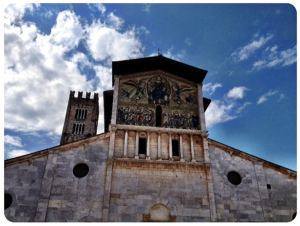 If
you have never been there will be for you a nice surprise.
Lucca, a beautiful and cultured city of ancient history, is
one of the most famous and visited places in Tuscany, a
stage for century of the Via Francigena, with many
foreigners who have chosen it as their second home and where
the music of Giacomo Puccini hovers. The city is enclosed
within a perimeter of 4 km of sixteenth-century walls, which
are a real symbol. Inside the walls, the old town has well
preserved the character of a "state city" of yesteryear,
with its narrow streets and characteristic squares,
overlooked by medieval farmhouses and Renaissance palaces.
City of 100 churches, Lucca is a paradise also for gourmets
and those who love shopping. If
you have never been there will be for you a nice surprise.
Lucca, a beautiful and cultured city of ancient history, is
one of the most famous and visited places in Tuscany, a
stage for century of the Via Francigena, with many
foreigners who have chosen it as their second home and where
the music of Giacomo Puccini hovers. The city is enclosed
within a perimeter of 4 km of sixteenth-century walls, which
are a real symbol. Inside the walls, the old town has well
preserved the character of a "state city" of yesteryear,
with its narrow streets and characteristic squares,
overlooked by medieval farmhouses and Renaissance palaces.
City of 100 churches, Lucca is a paradise also for gourmets
and those who love shopping.
 An
example of the popularity of the city is the fact that it
has been on the list of the most popular cities in America
for several years now. The structure of the Roman city, with
its thistle and decumanus, the two cross roads, is still
visible in the urban fabric. The
Lucca
Walls, which were never used militarily,
started in 1504 and finished a century later, 4.2 km long
and 30 meters wide, are the most famous symbol of the city,
place of endless walks and corsets in the tree-lined stands.
The circle of Roman remains of the city walls, which has
been transformed into charming houses that form the oval
frame of Piazza Anfiteatro, destined for aperitifs,
shows and events. An
example of the popularity of the city is the fact that it
has been on the list of the most popular cities in America
for several years now. The structure of the Roman city, with
its thistle and decumanus, the two cross roads, is still
visible in the urban fabric. The
Lucca
Walls, which were never used militarily,
started in 1504 and finished a century later, 4.2 km long
and 30 meters wide, are the most famous symbol of the city,
place of endless walks and corsets in the tree-lined stands.
The circle of Roman remains of the city walls, which has
been transformed into charming houses that form the oval
frame of Piazza Anfiteatro, destined for aperitifs,
shows and events.
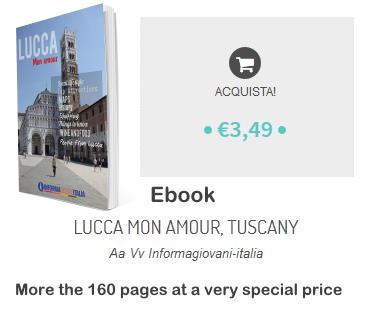 There
are 6 individual gateways to the city which lead into the
historical centre. For centuries, these ramparts have
protected Lucca from the expansionist ambitions of Florence
and Pisa, allowing Lucca to remain an independent state
until the mid-1800s, when it was ceded to the Grand Duchy
of Tuscany due to the financial problems of the then
Duke, Carlo Ludovico di Borbone. The public and
religious buildings in Lucca date back to the 11th and 12th
centuries, when, thanks to its merchants and bankers, the
city had an international economic importance. Many
dwellings of the municipal period, with some houses towers
still visible, like the other icon of the city, the There
are 6 individual gateways to the city which lead into the
historical centre. For centuries, these ramparts have
protected Lucca from the expansionist ambitions of Florence
and Pisa, allowing Lucca to remain an independent state
until the mid-1800s, when it was ceded to the Grand Duchy
of Tuscany due to the financial problems of the then
Duke, Carlo Ludovico di Borbone. The public and
religious buildings in Lucca date back to the 11th and 12th
centuries, when, thanks to its merchants and bankers, the
city had an international economic importance. Many
dwellings of the municipal period, with some houses towers
still visible, like the other icon of the city, the
 Guinigi Tower
and the
Guinigi Tower
and the
 Clock Tower.
Clock Tower.
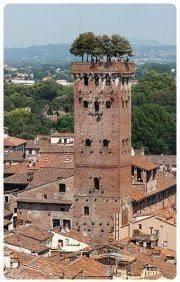 The
heart of the city is Piazza Napoleone, also called
Piazza Grande, where you can find the Palazzo Ducale,
the seat of the province (started in 1578 on a project by
architect Ammanati), the Teatro del Giglio and the
Istituto d'Arte; this large and tree-lined square, hosts
important city events such as
Lucca Comics at the end of
October/beginning of November and the Summer Festival,
which brings to the city in July, every year, the best of
music Not far away is the sumptuous The
heart of the city is Piazza Napoleone, also called
Piazza Grande, where you can find the Palazzo Ducale,
the seat of the province (started in 1578 on a project by
architect Ammanati), the Teatro del Giglio and the
Istituto d'Arte; this large and tree-lined square, hosts
important city events such as
Lucca Comics at the end of
October/beginning of November and the Summer Festival,
which brings to the city in July, every year, the best of
music Not far away is the sumptuous
 Cathedral of San Martino, a truly exciting
church, begun in 1200, erected on the remains of a previous
church of the VIII; the facade has a large portico and three
orders of loggias, marked by columns in light stone. The
Lucca cathedral contains several masterpieces, including the
Cathedral of San Martino, a truly exciting
church, begun in 1200, erected on the remains of a previous
church of the VIII; the facade has a large portico and three
orders of loggias, marked by columns in light stone. The
Lucca cathedral contains several masterpieces, including the
 legendary
The Holy Face, housed in a precious
temple by Matteo Civitali; the
Funeral Monument of Ilaria del Carretto by Jacopo
della Quercia commissioned by the Lord of Lucca,
Paolo Guinigi; the altarpiece by Ghirlandaio; a
Last Supper by Tintoretto, works by
Passignano, Fra Bartolomeo, Jacopo Ligozzi
and Alessandro Allori. A few steps further on, in the
square of the same name there is the
Church of Santa Maria Forisportam, a
jewel unfortunately forgotten, from the interesting history
that crosses the legend. The church dates back to the 13th
century and is in Romanesque-Pisan style, with three
Renaissance portals, and houses two exceptional works by legendary
The Holy Face, housed in a precious
temple by Matteo Civitali; the
Funeral Monument of Ilaria del Carretto by Jacopo
della Quercia commissioned by the Lord of Lucca,
Paolo Guinigi; the altarpiece by Ghirlandaio; a
Last Supper by Tintoretto, works by
Passignano, Fra Bartolomeo, Jacopo Ligozzi
and Alessandro Allori. A few steps further on, in the
square of the same name there is the
Church of Santa Maria Forisportam, a
jewel unfortunately forgotten, from the interesting history
that crosses the legend. The church dates back to the 13th
century and is in Romanesque-Pisan style, with three
Renaissance portals, and houses two exceptional works by
 Guercino...
Guercino...
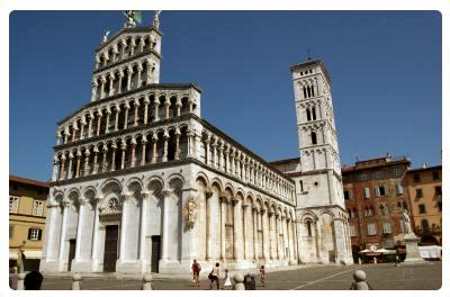 Going
back to Via San Paolino, we find another of the
squares in the heart of Lucca, Piazza San Michele,
with the homonymous
Church of San Michele in Foro, from the
first half of the twelfth century that blends the Pisan
style with the Roman-Lombard style. The interior has a Latin
cross and contains many exquisite works of art, including a
splendid Madonna and Child, in glazed terracotta, by
Andrea della Robbia, and a
table
that recalls the influences of Botticelli's workshop,
here by Filippino Lippi and depicting Saints
Jerome, Sebastian, Rocco and Elena Empress (known as
Pala Magrini, 1483). Going
back to Via San Paolino, we find another of the
squares in the heart of Lucca, Piazza San Michele,
with the homonymous
Church of San Michele in Foro, from the
first half of the twelfth century that blends the Pisan
style with the Roman-Lombard style. The interior has a Latin
cross and contains many exquisite works of art, including a
splendid Madonna and Child, in glazed terracotta, by
Andrea della Robbia, and a
table
that recalls the influences of Botticelli's workshop,
here by Filippino Lippi and depicting Saints
Jerome, Sebastian, Rocco and Elena Empress (known as
Pala Magrini, 1483).
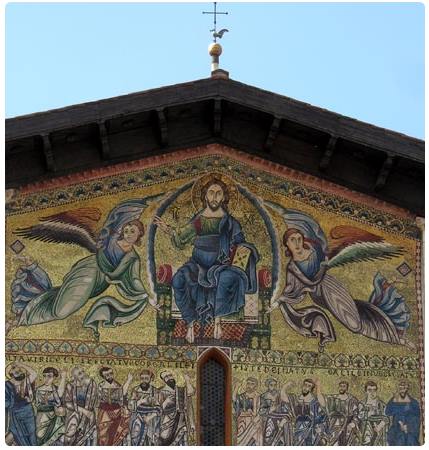 Another church that merges the Pisan-Roman-Romanian-Lombard
styles is the
Basilica of San Frediano, erected in honor of the
patron saint of Lucca, which has an enormous mosaic on the
facade that represents the ascension. Don't forget this
shining mosaic! The building has medieval origins, while its
mosaic dates back seven centuries later. The complex is
monumental, although collected in the small square that
bears its name; the mosaic, the interior architecture, the
cycle of Renaissance frescoes and the exquisite sculptural
works, make San Frediano one of the most beautiful
churches in Italy. The Another church that merges the Pisan-Roman-Romanian-Lombard
styles is the
Basilica of San Frediano, erected in honor of the
patron saint of Lucca, which has an enormous mosaic on the
facade that represents the ascension. Don't forget this
shining mosaic! The building has medieval origins, while its
mosaic dates back seven centuries later. The complex is
monumental, although collected in the small square that
bears its name; the mosaic, the interior architecture, the
cycle of Renaissance frescoes and the exquisite sculptural
works, make San Frediano one of the most beautiful
churches in Italy. The
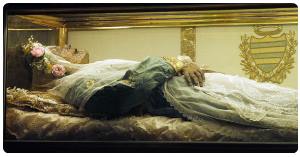 current
basilica, which began in the first XII century and was
consecrated in 1147 by Pope Eugene III. Many are the
masterpieces inside it, which we invite you to deepen in the
article dedicated to the church, but it is above all the
tomb of another saint loved by the people of Lucca, to
attract attention. It is
Santa Zita, whose mummified body, which has
remained uncorrupted, is still visible in the transparent
shrine. current
basilica, which began in the first XII century and was
consecrated in 1147 by Pope Eugene III. Many are the
masterpieces inside it, which we invite you to deepen in the
article dedicated to the church, but it is above all the
tomb of another saint loved by the people of Lucca, to
attract attention. It is
Santa Zita, whose mummified body, which has
remained uncorrupted, is still visible in the transparent
shrine.
Up
Airbnb Lucca
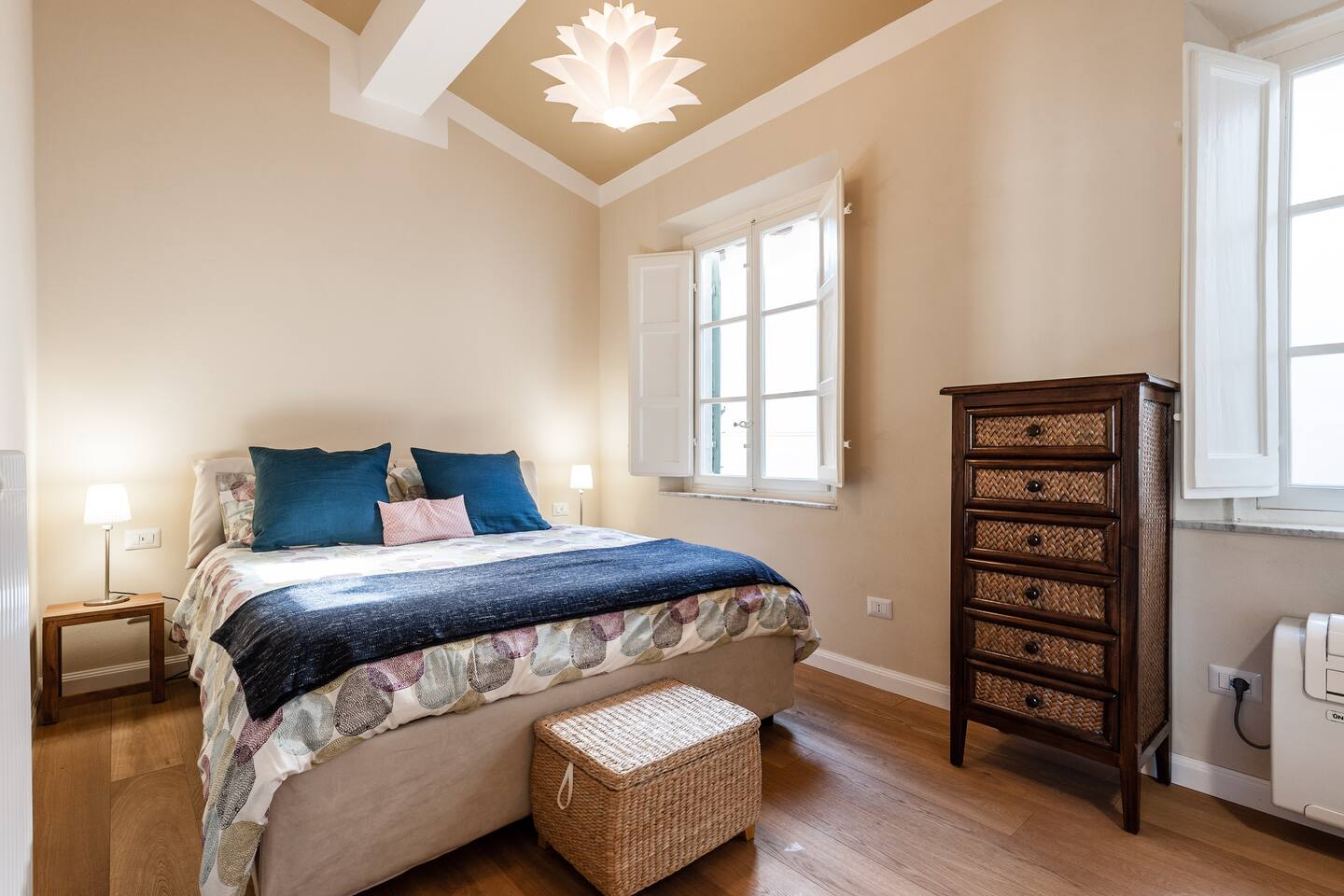
Perfect place to live your vacation in Lucca in the best
possible way. Apartment in the heart of the town, via
Fillungo and Anfiteatro, finely restored recently...
|
|
Up
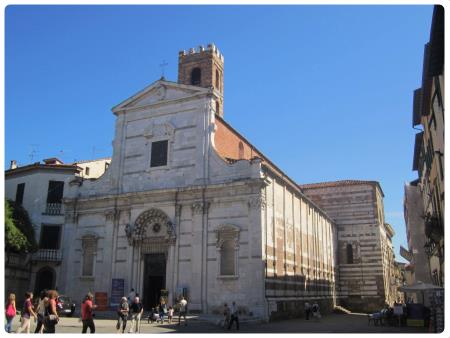 In
the city of 100 churches, there are many places of worship absolutely
interesting. One of these is the Church of Saints John and Reparata, in
the homonymous square, between Piazza Napoleone and Piazza San Martino. It is an
ancient basilica of Lucca, with a square Romanesque-Gothic baptistery built for
the first time in the fourth century and that until VII was the cathedral of the
city. It has been renovated several times and is now in the Romanesque style, of
which the portal of the façade remains, with the deep modifications of the
seventeenth century. Today the church houses a museum to allow you to visit the
historical stratifications with remains of several buildings dating back to the
first century. a. C. in the XII century. d. C., brought to light by an
excavation campaign begun in 1969. The remains of a Roman domus dating back to
the first century BC, of thermal baths from the I-II century. d. C., of the
early Christian church and Baptistery, of Lombard tombs, of the remains of the
early medieval Baptistery and of the Carolingian crypt, and the baptismal font
decorated with coloured marbles inlays. It is also an evocative location for the
concerts of Puccini and classical music that are held here every week. In
the city of 100 churches, there are many places of worship absolutely
interesting. One of these is the Church of Saints John and Reparata, in
the homonymous square, between Piazza Napoleone and Piazza San Martino. It is an
ancient basilica of Lucca, with a square Romanesque-Gothic baptistery built for
the first time in the fourth century and that until VII was the cathedral of the
city. It has been renovated several times and is now in the Romanesque style, of
which the portal of the façade remains, with the deep modifications of the
seventeenth century. Today the church houses a museum to allow you to visit the
historical stratifications with remains of several buildings dating back to the
first century. a. C. in the XII century. d. C., brought to light by an
excavation campaign begun in 1969. The remains of a Roman domus dating back to
the first century BC, of thermal baths from the I-II century. d. C., of the
early Christian church and Baptistery, of Lombard tombs, of the remains of the
early medieval Baptistery and of the Carolingian crypt, and the baptismal font
decorated with coloured marbles inlays. It is also an evocative location for the
concerts of Puccini and classical music that are held here every week.
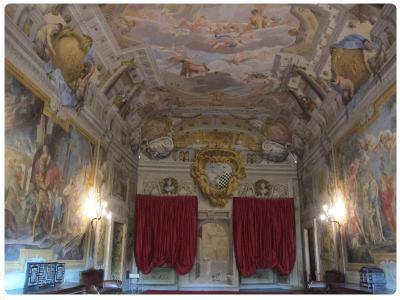 Among
the civil buildings we remember the Villa of Paolo Guinigi of 1418, which
houses the
National Museum Guinigi, absolutely not to be missed, with
sculptures and finds from the Middle Ages to the end of 1800, Etruscan, Roman
and Ligurian archaeological material. The so called Pinacoteca Nazionale,
on the other hand, is located in the 17th century Palazzo Mansi and contains an
exceptional collection of paintings by Italian and foreign artists such as:
Vasari, Jacopo da Bassano, Tintoretto,
Veronese, Bronzino, Andrea del Sarto,
Guido Reni, Domenichino, Pontormo,
Pompeo Batoni.
Finally, don't miss two other places dear to Lucca, the Botanical Garden and the
house that you will see at number 9 of Corte San Lorenzo. The second place, the
house, is the birthplace of the great composer Giacomo Puccini. Sue are
some of the most famous works music Opera compositions, Boheme, La
Tosca, the Tourandot.... Puccini was born in this part of the
historic center of Lucca, a few steps from Piazza San Michele, in 1858 and here
lived much of his youth, before Among
the civil buildings we remember the Villa of Paolo Guinigi of 1418, which
houses the
National Museum Guinigi, absolutely not to be missed, with
sculptures and finds from the Middle Ages to the end of 1800, Etruscan, Roman
and Ligurian archaeological material. The so called Pinacoteca Nazionale,
on the other hand, is located in the 17th century Palazzo Mansi and contains an
exceptional collection of paintings by Italian and foreign artists such as:
Vasari, Jacopo da Bassano, Tintoretto,
Veronese, Bronzino, Andrea del Sarto,
Guido Reni, Domenichino, Pontormo,
Pompeo Batoni.
Finally, don't miss two other places dear to Lucca, the Botanical Garden and the
house that you will see at number 9 of Corte San Lorenzo. The second place, the
house, is the birthplace of the great composer Giacomo Puccini. Sue are
some of the most famous works music Opera compositions, Boheme, La
Tosca, the Tourandot.... Puccini was born in this part of the
historic center of Lucca, a few steps from Piazza San Michele, in 1858 and here
lived much of his youth, before
 moving
to Milan in 1922. Today, the birthplace is now used as a museum, administered by
the foundation dedicated to the great Italian composer. You can admire the
furnishings and objects used by the family, including the various awards
received by the master during the first phase of his career, which began in
Lucca as organist in the nearby Church of San Paolino. The second is the
Botanical Garden, an enchanted place suspended between the walls and the
city, which stretches for two hectares in the south-eastern corner of the
historic center. Founded in 1820 by Maria Luisa di Borbone, Duchess of
Lucca (but on the initiative of Elisa Bonaparte in 1814), the Garden is
divided into various sectors such as the arboretum, the lake etc. An oasis of
beauty and tranquility. moving
to Milan in 1922. Today, the birthplace is now used as a museum, administered by
the foundation dedicated to the great Italian composer. You can admire the
furnishings and objects used by the family, including the various awards
received by the master during the first phase of his career, which began in
Lucca as organist in the nearby Church of San Paolino. The second is the
Botanical Garden, an enchanted place suspended between the walls and the
city, which stretches for two hectares in the south-eastern corner of the
historic center. Founded in 1820 by Maria Luisa di Borbone, Duchess of
Lucca (but on the initiative of Elisa Bonaparte in 1814), the Garden is
divided into various sectors such as the arboretum, the lake etc. An oasis of
beauty and tranquility.
Entering through the Porta Sant'Anna you will find
yourself in Piazzale Verdi; in days gone this served as the
location for many executions. On your left you will find the
tourist information office, where you can pick up a detailed
map of the city. In the following chapters we explore the
following topics: things to do and see, history, sight seeing in
and around the city, food, famous inhabitants, curiosities,
shopping etc. Discover
What to see and do in Lucca.
Festivals and events in Lucca
There are numerous festivals and events all year round in Lucca.
On September 13th there is a celebration very dear to the people
of Lucca, Santa Croce, a religious celebration with the
procession of the Holy Face, a great crucifix, in the
city illuminated only by thousands of lights. Santa Zita,
on April 27th with the flower fair, the Summer Festival,
in summer with guests like Robin Williams, Elton John....
Lucca Comics and Games, at the end of October, an exhibition
of world-famous comics and games, with 80,000 visitors per day,
Murabilia, a gardening festival at the beginning of
September, in the suggestive setting of the ramparts on the
walls; July 12th celebrates San Paolino....
After visiting Lucca, if time permits, we recommend to
discover
Lucca's
surroundings.
Copyright © Informagiovani-italia.com.
Map
Up
Ostelli Lucca
Ostelli Italia
Auberges de
Jeunesse Italie
Hotel Lucca
Carte Lucques
Karte von Lucca
Mapa Lucca
Map of Lucca
Carte
de la Toscane
Karte von Toskana
Mapa Toscana
Map of Tuscany
Carte d'Italie
Karte von Italien
Mapa Italia
Map of Italy
|